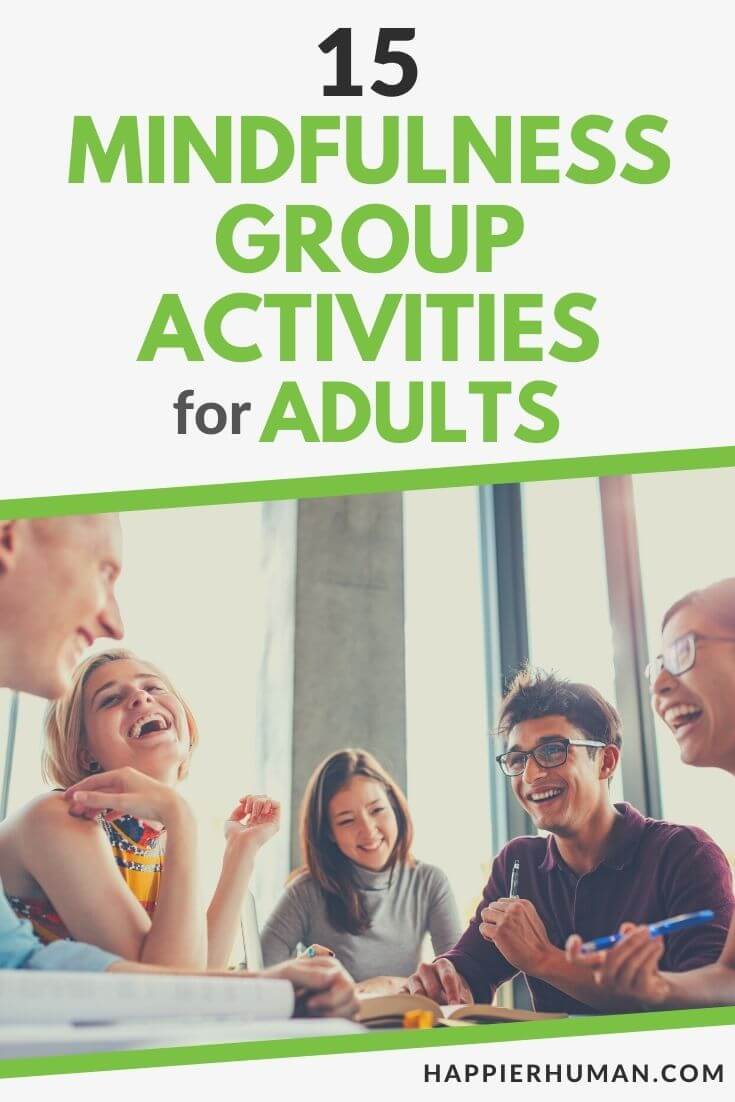There might be affiliate links on this page, which means we get a small commission of anything you buy. As an Amazon Associate we earn from qualifying purchases. Please do your own research before making any online purchase.
Getting into meditation and mindfulness can be a lot easier if you have a healthy group to practice your new healthy habits with. If you are looking for ways to create a mindfulness practice routine, there are some great tools out there for you and your friends to use.
You might have noticed that people do things in groups. It is only natural!
We are social creatures, and we can learn a lot from practicing just about anything with like-minded people.
From yoga classes to study groups, a communal atmosphere can help us progress faster than working alone. Mindfulness is no different, but you will need some new tools to make mindfulness group practice a part of your life.
If you are new to the idea of mindfulness, please take a minute to read about: 10-Minute Mindfulness, which is a very helpful book we put together to show people how easy it is to start practicing mindfulness in your daily life.
The good news is that any kind of mindfulness practice will help you grow your overall levels of awareness, regardless of whether you practice with a group, or on your own!
Mindfulness Matters
In some ways, mindfulness and meditation are one and the same thing.
If you are thinking about meditation as sitting in the lotus position and chanting…well…that is just one kind of meditation. In truth, meditation can take on many forms, and some of the mindfulness activities we talk about below are forms of group meditation.
It is important to understand the overlaps between mindfulness and meditation because they will both create many of the same positive things in your body and life. Mindfulness has been shown by medical professionals to lower stress levels and promote a happier mental outlook.
There is a lot of stress in our modern lives, which has been linked to numerous medical conditions, including heart attacks and strokes. Mindfulness might be a relatively new idea in the West, but these group mindfulness activities can help you and your friends to gain from age-old Eastern stress-reduction techniques.
15 Mindfulness Activities for Adults
Think about what you did with your friends last week.
Dinner out?
Maybe some drinks at a bar, or in someone's apartment?
There is nothing wrong with blowing off some steam at your local watering hole, but you don't want it to become a coping mechanism for stress. Here are some great group activities that can help you and your friends practice mindfulness, and learn new ways to live a happier, healthier life.

Some of these activities will require that one person in the group act as the ‘guide'. All this means they will have to focus on leading the group through the exercise.
The guide for these activities doesn't need to be more experienced in mindfulness practice, just willing to keep track of what to do during the activity, and ready to help their friends through a mindfulness practice session!
Activity #1: Body Scan
It might seem a little bit strange, but most of us don't listen to our bodies with the attention they deserve. The body scan is a great mindfulness group activity that helps us slow down, and reconnect with our physical vehicle.
It is a good idea to do this activity in a relaxed setting where it is possible to lay down comfortably. An apartment or home would be fine, but a natural space with soft grass would also be great. This mindfulness exercise will require a guide, who will be responsible for helping the group to progressively scan each area of their bodies with their awareness.
To begin the body scan, the group will find a comfortable position, such as laying on the floor or sitting in a chair. The position isn't important, but it should be comfortable to hold for 20+ minutes.
Step ONE: Once everyone is in a comfy position, the guide will begin to help the group focus on a part of their bodies. The breath should be used as a way to establish initial focus, much like some forms of meditation. It is best to be still during this exercise and in a relaxed place.
Step TWO: After the breath comes into focus, the guide should tell the group to become aware of how their bodies feel. Take note of any soreness, or just how their clothing feels. Once this awareness is held for a minute or two, the body scan can begin.
Step THREE: The guide will tell the group to focus on a specific part of their bodies. Many people begin with the toes or feet, but if you have your own ideas, go for it. The awareness is held in a specific area for a minute or two and then shifted on. The guide should tell the group to wait for the next area before moving on.
Step FOUR: Once the entire body has been given mindful attention, the focus can be brought back to the breath for a few minutes. The energy in the room is likely to be extremely relaxed, so a few moments of relaxed breathing should feel great. The guide can once again tell the group to note any feelings that seem out-of-the-ordinary.
After the body scan, the group can sit and talk about what they experienced, and share the feelings they had. This exercise is also a great intro to meditation, and anyone who participates should feel calm after it is completed.
Activity #2: Shared Self Compassion Session
It might seem a little counterintuitive, but many people who learn mindfulness and healing tend to forget themselves. All that great caring energy is projected on to others, and the person who is making it happen gets forgotten (by themselves!).
We need to be compassionate to ourselves, and a shared self-compassion session can be a good tool for making that happen. Suffering is universal, so finding something to use self-compassion for should be pretty simple.
There are many ways to do this mindfulness-building exercise, and a basic form is given below.

Don't be afraid to add your own touch to this exercise, or even practice it on your own. It is a good idea to do a little bit of mindful breathing before the exercise starts, as thinking about suffering tends to get us a little riled up (stress response).
Step ONE: It is a good idea to have everyone bring a notebook or something they can write with. Once everyone is sitting down in a comfortable position, you can all start writing out something that has been painful. There is no limit to what could be the subject of self-compassion; it could be a parking ticket, or an extremely traumatic life challenge.
Step TWO: Once everyone has written down one thing that is painful, the group can take turns reading what they have written, and talk about why it is important they feel compassion for themselves. After a person has finished talking, the group can express feelings of compassion for the person, so they feel that their self-compassion is being reinforced externally.
If the people in your group are already friends, the end of a person's time can be finished with a hug from the next person who will share. This is totally optional, but a hug from a friend can do a lot to show how much better we feel when we share what is painful to us.
Step THREE: The group will continue to share the painful things that have been written down until everyone has participated.
It is important to understand that sometimes a person may write down something that is painful but be unable to share it. Don't push, give them a chance to write something else down, or just sit with the group.
Activity #3: Mindful Snacking
Most people love to have a snack, but we don't always pay mindful attention to our food. Mindful snacking isn't too good to be true, in fact, becoming aware of our minds from the act of eating is a great way to see how much we let slip by on a daily basis. Like most of the exercises in this short guide, there is a lot of wiggle room when it comes to how your group practices mindful eating.
The basics are:
The reason why this exercise can be so effective is that we eat a lot, and it is easy to integrate mindfulness into your meals after you get used to the practice.
Many people treat food as a necessity and have stopped ‘tasting' what they eat. If a person slows down and becomes aware of the flavors, textures, and interior experiences of mindful eating, they may be surprised at how much they miss every day.
If this sounds a little bit like a gourmet ‘tasting', you are picking up on a great opportunity for a mindfulness eating crossover event. There is no way to get to know food better than tasting it with all the awareness that is possible, which can help people to build a more refined palate.
Activity #4: Coloring Book Party!
It doesn't matter how old you are, coloring books are a wonderful way for your group to practice focus and mindfulness. There are loads of adult coloring books out there. Some are very complex and made for adults, but you can use any kind of coloring book you want.
Remember, this isn't an art contest.
The only reason why your group is coloring is to focus on a task and let go of the habitual mind that causes so much stress and overthinking. Sharing the coloring pages as a group is a great idea, as long as everyone understands that the goal is to let go of making judgments, not embrace it.
Activity #5: Looking Out The Window Together
This activity doesn't have to be done with a window, but the sunlight from the outside is a natural way to lift your mood. We use our eyes on a near-continuous basis when we are awake, so ‘seeing' becomes an almost automatic process.
Mindful vision exercises take something we do all day long and introduce focused awareness into the act of looking. To begin, it is good to have a pleasant scene, which is why the outside world can be a good subject. It is also nice to have some motion in the image, but it isn't necessary.

This exercise can be as simple as looking out a window as a group for a period of time, or it can also take on the form of a discussion group. It can be interesting to have people write down thoughts and associations that come into their minds as they look mindfully, and then talk about it after the session is complete.
Mindful looking can also be practiced in a novel environment, like a nature reserve or art museum. Making an event of mindfulness is a great way to focus even more attention on being aware, which can help people who are just starting out in this area of practice.
Activity #6: Visit a Wonderful Feeling
Life has some great moments, and we need to be wise enough to cultivate that lovely joyful energy.
Mindfulness is all about the present moment, but it is ok to be grateful for pleasant things that have happened in your life. In this exercise, everyone in the group will find something in their life they are grateful for and gave them wonderful feelings.
It is important not to try and recreate the good feelings, as chasing after good things that happened in the past will pull you out of the present moment. Instead, everyone in your group can be grateful in the present moment, and then share the thing they are grateful for.
When people in the group are sharing, the rest of the group can practice mindful listening. We can overlook things in our own lives that are worthy of gratitude, which is one of the most positive energies we can cultivate.
If you want to learn more about mindful listening, please keep reading!
Activity #7: Mindful Listening Activities
When we have to do something all day long, we tend to just go into ‘autopilot mode'. Mindfulness is one of the ways we reestablish awareness of our lives, and mindful listening is one of the most important ways we can practice both focus, and giving attention.
Mindful listening is easy to practice in a group. Your group can pair off into partners, or a ‘speaker' can share information with the group. It should be easy to see that this kind of practice can be used with other exercises in this guide, and will likely make them more effective for everyone in the group.
At its core, mindful listening is simply focusing on the person who is talking, in the same way, that you would focus on your breath in meditation. Like most mindfulness activities, the simplicity of focusing on something will create incredible results.
The mindful listening group activity can be simple, and people in the group can simply share something meaningful to them with the group, or once everyone has spoken, the group can take turns talking about what they felt when they were speaking or listening.
Activity #8: Group Dancing
Mindful dancing is a simple way to let go of thinking. There is no special dance or goal of mindful dancing. All your group has to do is turn on some good music, and start moving. Don't focus on anything but feeling joy, and moving your body. Mindful dancing is also a great way to end a mindfulness group, as it usually leaves everyone feeling incredible.
Activity #9: Balloon Play
Balloons don't cost a lot of money, and they are genuinely fun to play with. Mindful balloon play can take on numerous forms, but one of the easiest is a game of balloon ‘hacky sack'. All your group has to do is sit in a circle, and keep the balloon from touching the ground.

There are no winners or losers in this game, and your group can play with more than one balloon at a time. Once your group focuses on the balloons and keeping them up in the air, the mind will calm down, and all those worries will fade into the background.
Don't be afraid to make up your own versions of the balloon exercise. Once your group has inflated the balloons they can be used for different things during the day. They also look fun sitting around the room and add something to any event.
Activity #10: Expressive Writing Exercise
While journaling is all about getting connected with your experiences through writing, expressive writing is about processing emotions. Coping with stressors. The writing exercise lets group members reflect on meaningful memories, and then capture details of the day. Members focus on building confidence, as well as reducing troublesome stress… without judging themselves for how or what they are feeling.
Whether your group meets once a day or several times a week, expressive writing as a group is sure to improve everyone's mood. Expressive writing allows you to channel your stress by writing without stopping. Group members can later challenge their anxious thoughts, beginning by learning to live in the moment and then take note of the present. The group leader should discuss how to be present, while helping members learn about themselves. This is self-awareness, a process that works well with more than one participant.
Either way, self-reflection should take priority in your life. As a guided exercise, recording your thoughts creates space for you to stop after 10 or 15 minutes – look away, take a deep breath, and come back to what you've written. Before each group member, there will be one to two short pages of text, written in an unorganized fashion. Each page should leave every member feeling calmer, more focused, and less stressed than before. Here's how anyone can go about accomplishing that feeling, starting with finding the best environment to do the exercise.
Step ONE: Gather the group at a single location. The group leader should quiet the room, turn on soothing, meditative music, and then ask everyone one at a time to describe one thing they like to do when they're stressed, upset, anxious, or annoyed. The group leader should ask them to discuss what's bothering them at the moment, allowing each member the chance to feel without judging.
Step TWO: Relax before writing. Hands should be free, eyes shut, and ears focused on the music. Members should be still for five minutes after being physically active. Like with guided meditation, each group member will inhale deeply, hold their breath, and exhale slowly. In doing so, they'll release tension and stress, increase concentration, and relax.
Step THREE: Group members should begin writing freely. The group leader should prompt the memories of members as they write, focusing on questions that make each member mindful of the present calmness. The soothing after a grueling day, the changes in their breathing as they record one detail after the next. The exercise is powerful, healthy, and paramount in reducing worries and stressors.
For the best results, gather the group several times a week. Group members who focus on the present can practice gratitude, recognizing the advantages of a situation while progressing further from negative thinking.
Activity #11: Morning Coffee for Mindfulness
Coffee is a stimulant that millions of people swear by. So much, that without its consistent consumption, humans turn grumpy and moody and have trouble staying awake. Why not take advantage of everyone's favorite morning beverage? How about getting the group together for coffee?
If there's anything great about a cup of joe, it's the rush of attentiveness that comes soon after sipping. From the taste to the aroma, the sensation of pouring this hot beverage down your throat can fill your mind with contentedness, enough of which will make for quiet, calming conversation.
Rather than sit in the quiet, embrace the group in some gratitude exercises. But be sure to make sure everyone points out one thing in the immediate environment they're grateful for. A member might be grateful for the radiant colors of another group member's shirt. Or, they might appreciate the smell of chocolate and cinnamon nearby. By learning to connect with one's environment, group members ground themselves in the present, dismissing everything that doesn't matter at the time.
Activity #12: Music Appreciation Exercise
There is nothing as beautiful as the sound of music. When happy and content, music brings joy to the ears. When sad or distraught, music might bring us deeper into those emotions, sometimes even allowing us to go so far as to cry or laugh in response. The reasoning for listening to music might fluctuate, but there are plenty of benefits in addition to the burst of motivation people get from hearing a great tune. Of course, a group that gathers to listen to music can enjoy the benefits even more so, as long as they decide carefully which music to choose, and how long to listen to the chosen selection.
When choosing music, consider:
Music will create the most positive feelings for a group as long as everyone has a turn. Group leaders should make sure each group member can choose a song or band to listen to. Allowing everyone the chance to listen to their favorite songs adds diversity and depth to the tones, rhythms, and styles members may hear.
Learn more about the healing power of music therapy.
Activity #13: Mindfulness and Stretching Exercises
Stretching exercises are a great way for members of the group to get their bodies moving and their minds at ease. Even basic stretching exercises like clasping your fingers together and reaching as high as you can will loosen the muscles and help you feel better… but, more importantly, stretching can help take group members' minds off of their worries. Instead of focusing on the pain of the day, there's the gentle strain that comes with a nice series of stretches. For people who stretch, it doesn't take long before they notice a change in how they feel and think.

Most people spend a lot of time living a sedentary lifestyle filled with consecutive hours of sitting. Whether its tight office cubicle arrangements or hours working from home, the modern era has shifted ever closer to most employees not getting enough movement in their lives. Stretching, fortunately, has the benefit of improving motion and flexibility, so that adding time for participants to stay mindful feels natural for all members involved.
Here are three important matters to remember when stretching:
While stretching, mind and body connect. Members will feel more relaxed, happy, comfortable, and present during and after stretching. For the best results in a group stretching activity, everyone should aim to hold their stretches for 60 seconds, at least 15-30, and repeat no less than two, but ideally, four repetitions. Stretching improves mobility and keeps you from getting hurt. Be sure to add this group exercise to your list of mindfulness activities.
Activity #14: Mindful Gardening Exercises
Where there's mindfulness, there's gardening. And with the planting of seeds comes harmony, peace, freedom from stress – and fun. Gardening places the group in the middle of nature. There, they'll be able to interact with nature, embracing a deeper sense of purpose through a meaningful gardening activity. From preparing the garden's layout to watering and fertilizing plants, you and other members can spend a few hours doing work that matters. We're talking relaxing work that allows you to use all five of your senses.
Even better? Mindful gardening activities work best with a guide. So, the members walk away feeling energized and refreshed, all thanks to 1-2 hours of planting. Members should get into a flow state where they lose track of the physical demands, and in doing so, find the gardening activity enjoyable and emotionally rewarding. It'd be hard to be very present in your surroundings if group participants are overwhelmed with the stress of the work. For mindful gardening activities, the exercise should be centered around a quiet planting session rather than anything too hard on the body. Participants should expect to expand their focus and improve their wellbeing, as leaders offer encouragement and guidance meant to support awareness of one's immediate surroundings.
Gardening is emotionally stimulating and helpful for the body. With a leader's guidance, positive words and a comfortable environment will succeed in calming the minds of group members as they complete the exercise.
To garden as a mindfulness activity, first, you'll need to gather plants and supplies as a group. Group members should decide which plants produce the strongest positive reaction and explain the reason why to the rest of the group. Recognizing the emotional benefits of gardening prior to work will prepare each member for a soothing and enjoyable activity. While picking out vegetables and flowers, members should gather equipment and equipment as a group.
The sense of togetherness that comes with shopping as a group will add more meaning to the activity. Gardening hoses, pruning shears, sprinklers, and rakes are essential to gardening. But for comfortable gardening, don't forget knee pads and the most effective tools, both of which might include the latest product or something more carefully thought out. You should know.
The best way to make gardening work for mindfulness is to concentrate on the steady rhythm of the work. Gardening should be mostly quiet aside from the group leader's reinforcement. In the end, members will feel refreshed and less stressed, and likely aware that they're tired, feeling good, and proud they accomplished good work.
Activity #15: Book Readings for Mindfulness
Reading alone carries enough benefits to transform how people in a group feel. Books present limitless learning opportunities for groups, from chances to think critically and reflect or have deep discussions surrounding a topic.
Group members interested in reading should think of the authors and subjects they find most fascinating. By the time the group's underway, members should take turns reading passages from the book. Reading like a team will help people slow down and learn. Each reader will have a different way of speaking, so interpretation depends on every member hanging onto every word.
Reading for mindfulness is possible when group members develop the habit of questioning what's on the page. One reader may analyze the opening of a text and come to a completely different conclusion regarding the book's first few pages than another.
The mindfulness benefits are there when group members become deeply immersed in discussion surrounding the most intriguing arguments mentioned in a book. Hours can fly by as group members become more captivated and focused. Everyone learns more, and everyone has fun in the process. Overall, group book readings are an excellent way to let people connect with deeper meanings in their lives.
Conclusion
Mindfulness isn't a new idea, but it is finally being embraced by a wider group of people.
It is easy to learn, and can be practiced almost anytime, and in any situation. Individual mindfulness practice is a great way to improve your awareness, but group mindfulness exercises are also indispensable in growing your mindfulness skills.
If you are new to the ideas that this guide has talked about, please have a look at: 10-Minute Mindfulness, which we created to help people get into mindfulness practice.
You can start working on mindfulness at home, and you will probably be surprised at how much it can help with your stress and interpersonal relationships.
Life isn't going to stop being stressful, but with mindfulness and compassion, you can feel a lot better about life. For more information about how mindfulness and compassion work together, please have a look at this article, and see how scientific research backs up the power of compassion!
Finally, if you want a simple way to reduce your stress and anxiety, then try writing these 35 mindfulness journaling prompts to live more in the present moment.

Nicholas Say was born in Ann Arbor, Michigan, and has been interested in global belief systems from a young age. This area of study led him to research many Eastern philosophical systems, including Vedic and Buddhist ideas and practices. Today he thinks that humanity needs to find ways to be happy with being, as opposed to possessing and doing. His views fall roughly in-line with the late philosopher Alan Watts, who he venerates as great teacher.


